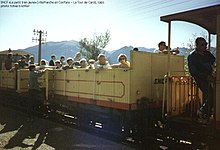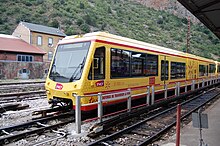Ligne de Cerdagne
| Villefranche-de-Conflent-Enveitg | |||||||||||||||||||||||||||||||||||||||||||||||||||||||||||||||||||||||||||||||||||||||||||||||||||||||||||||||||||||||||||||||||||||||||||||||||||||||||||||||||||||||||||||||||||||||||||||||||||||||||||||||||||||||||||||||||||||||||||||||||||||||||||||
|---|---|---|---|---|---|---|---|---|---|---|---|---|---|---|---|---|---|---|---|---|---|---|---|---|---|---|---|---|---|---|---|---|---|---|---|---|---|---|---|---|---|---|---|---|---|---|---|---|---|---|---|---|---|---|---|---|---|---|---|---|---|---|---|---|---|---|---|---|---|---|---|---|---|---|---|---|---|---|---|---|---|---|---|---|---|---|---|---|---|---|---|---|---|---|---|---|---|---|---|---|---|---|---|---|---|---|---|---|---|---|---|---|---|---|---|---|---|---|---|---|---|---|---|---|---|---|---|---|---|---|---|---|---|---|---|---|---|---|---|---|---|---|---|---|---|---|---|---|---|---|---|---|---|---|---|---|---|---|---|---|---|---|---|---|---|---|---|---|---|---|---|---|---|---|---|---|---|---|---|---|---|---|---|---|---|---|---|---|---|---|---|---|---|---|---|---|---|---|---|---|---|---|---|---|---|---|---|---|---|---|---|---|---|---|---|---|---|---|---|---|---|---|---|---|---|---|---|---|---|---|---|---|---|---|---|---|---|---|---|---|---|---|---|---|---|---|---|---|---|---|---|---|---|
| Route number (SNCF) : | 669,000 | ||||||||||||||||||||||||||||||||||||||||||||||||||||||||||||||||||||||||||||||||||||||||||||||||||||||||||||||||||||||||||||||||||||||||||||||||||||||||||||||||||||||||||||||||||||||||||||||||||||||||||||||||||||||||||||||||||||||||||||||||||||||||||||
| Route length: | 62.560 km | ||||||||||||||||||||||||||||||||||||||||||||||||||||||||||||||||||||||||||||||||||||||||||||||||||||||||||||||||||||||||||||||||||||||||||||||||||||||||||||||||||||||||||||||||||||||||||||||||||||||||||||||||||||||||||||||||||||||||||||||||||||||||||||
| Gauge : | 1000 mm ( meter gauge ) | ||||||||||||||||||||||||||||||||||||||||||||||||||||||||||||||||||||||||||||||||||||||||||||||||||||||||||||||||||||||||||||||||||||||||||||||||||||||||||||||||||||||||||||||||||||||||||||||||||||||||||||||||||||||||||||||||||||||||||||||||||||||||||||
| Power system : | 850 V = | ||||||||||||||||||||||||||||||||||||||||||||||||||||||||||||||||||||||||||||||||||||||||||||||||||||||||||||||||||||||||||||||||||||||||||||||||||||||||||||||||||||||||||||||||||||||||||||||||||||||||||||||||||||||||||||||||||||||||||||||||||||||||||||
| Maximum slope : | 60 ‰ | ||||||||||||||||||||||||||||||||||||||||||||||||||||||||||||||||||||||||||||||||||||||||||||||||||||||||||||||||||||||||||||||||||||||||||||||||||||||||||||||||||||||||||||||||||||||||||||||||||||||||||||||||||||||||||||||||||||||||||||||||||||||||||||
| Dual track : | No | ||||||||||||||||||||||||||||||||||||||||||||||||||||||||||||||||||||||||||||||||||||||||||||||||||||||||||||||||||||||||||||||||||||||||||||||||||||||||||||||||||||||||||||||||||||||||||||||||||||||||||||||||||||||||||||||||||||||||||||||||||||||||||||
|
|||||||||||||||||||||||||||||||||||||||||||||||||||||||||||||||||||||||||||||||||||||||||||||||||||||||||||||||||||||||||||||||||||||||||||||||||||||||||||||||||||||||||||||||||||||||||||||||||||||||||||||||||||||||||||||||||||||||||||||||||||||||||||||
The Ligne de Cerdagne is an electrically operated narrow-gauge railway in meter gauge , which, as a mountain railway , opens up part of the French-Catalan Pyrenees . It is operated by TER , a subsidiary of the French railway company SNCF .
While the railway is called Canari (canary bird) or Petit train jaune (small yellow train) in French because of its striking yellow paint , or Tren groc in Catalan , it is also known as the “Pyrenean metro ” in German-speaking countries . It undoubtedly received this name because of its form of operation, which is rare in continental Europe in the open country: The traction voltage of 850 V direct current is supplied by means of a side conductor rail coated from above .
The railway and its route have been on the UNESCO World Heritage waiting list since 2002 .
The distance
The Ligne de Cerdagne is the continuation of a standard gauge line starting from Perpignan , opening up the province of Roussillon and ending in the fortress town of Villefranche-de-Conflent . This is the operational center of the “Train jaune” with workshops and other facilities.
Despite the large differences in altitude, the route is used as a pure adhesion railway without cogwheel routes, which places special demands on the locomotives. The 62-kilometer route leads through an impressive landscape, over numerous bridges and through 19 tunnels.
history
With the opening of the first section of the Cerdagne line in 1910, Villefranche became a transfer station for the narrow-gauge railway.
During the construction of the line, a serious railway accident occurred on October 31, 1909: During the load test of the Cassagne bridge , the load train got out of control, escaped and crashed. Six people died in the railway accident , nine more were injured. Albert Gisclard , the bridge's designer, was among the dead .
Route
At the beginning, the route from Villefranche follows the steeply rising and canyon-like narrowing valley of the Têt , in which the traction energy is also generated using hydropower . Numerous sections show the maximum gradient. After almost 20 kilometers, the difference in altitude to the starting point is already 600 meters and the route changes the valley side at Fontpédrouse by means of the brick arched bridge Pont Séjourné . The route then continues to gain height and crosses the valley again between the Sauto and Planes stations on the Pont de Cassagne cable-stayed bridge . The Pont de Cassange is also called Pont Gisclard after its designer who died while building the railway and belongs to a type of bridge that was only used in France in Europe.
The railway leaves the Conflent here and reaches its provisional end point at the time it opened in 1910 at Mont-Louis - La Cabanasse in Cerdagne . Just a year later, the next section to Bolquère was built, where the route reaches its apex at 1,592 m above sea level and thus also the highest point in the SNCF network, and immediately descends to the popular winter sports resort Font-Romeu . From here on, the route continues downhill in curvy lines. The train reaches the high valley of the Cerdagne via Saillagouse and the small pilgrimage town of Err . In Bourg-Madame was until 1928 the last stop. When the lines from Toulouse and Barcelona met at Latour-de-Carol - Enveitg station , the narrow-gauge railway was also extended there. With that it had reached its total length of 63 kilometers. The travel time for the entire route is just under three hours.
In the Latour-de-Carol - Enveitg station, three lines with different gauges meet, which is rare. It is also noteworthy that three mountain railways meet here, each of which reaches a highest point in the respective network: The SNCF standard gauge overcomes an altitude of 1567 m near Andorra ; this is the highest point that a standard gauge railway reaches in adhesion operation in Europe. The Iberian broad gauge line to Barcelona, in turn, reaches the highest point in the network of the Spanish railway company RENFE in the Tosas tunnel at 1,494 m .
Train on the Pont Séjourné , 1985
Cable-stayed bridge Pont de Cassagne (also Pont Gisclard )
Railcar set with observation car in the Latour-de-Carol - Enveitg station
The vehicles

To develop the upper Conflent and the Cerdagne, electric traction was used from the start. On the one hand, hydropower was available in large quantities, on the other hand, gradients of up to 60 ‰ had to be overcome. In order to get by without a rack , you needed as large a number of driven axles as possible. For this reason, four-axle railcars equipped with the Sprague multiple control system were ordered, as had already proven themselves on the Paris Metro . Such equipped railcars were also procured for freight transport.
When it opened in 1910, ten passenger railcars, ten goods railcars, 14 passenger side cars and a large number of freight cars were procured, which have undergone some significant changes over the years. With the extension of the route, several sidecars were converted into railcars, in 1937 six four-axle sidecars with open platforms came to the Pyrenees. The sidecars are lined up alternately with the railcars; for reasons of traction, the rule of thumb is that there must be one railcar in the train set per sidecar. After a wave of decommissioning in the fifties of the 20th century, 14 passenger railcars and two freight railcars remained in the operating status as work vehicles. During this period of extensive line closures, the Cerdagne did not want to make any major investments, so instead of purchasing new ones, the decision was made to undergo a general overhaul of the vehicles that were in urgent need of renovation, which essentially consisted of sheet metal on the wooden car bodies and the installation of half-windows. Around the mid-1970s, the last modest freight traffic was then discontinued.
When the railway was about to decay again in the early 1980s, far-reaching changes were made that also affected the organization of operations. For example, the formerly independent operation was outsourced to offices on the adjacent standard-gauge lines and the vehicle fleet was rebuilt again after considerations of acquiring new tram-type vehicles proved unsuitable for the special conditions of this line. The original railcars received new steel boxes, improved suspension, low-voltage auxiliary systems and modern driver's cabs with seated service while maintaining the original appearance.
Since this conversion still did not represent a long-term solution, a suitable successor was looked for. It was found with the Stadler GTW from the Swiss company Stadler, which is already in use on numerous railways in Europe . Two new-build vehicles have been in use since 2004: the railcars have air conditioning, toilets and undivided panoramic windows, but are not compatible with the old-build vehicles. This also means that the open observation car, which is popular with the public, cannot be taken along. In order to preserve the identity of the railway as “the little yellow train”, they too have the characteristic yellow paint.
business
The number of passengers on the railway shows considerable seasonal differences: outside the high summer season, demand is low. This threatened to endanger operations. In 2015, however, the regional assembly of the Languedoc-Roussillon region approved a loan of € 14 million. Its purpose is to renovate the railway infrastructure and historic vehicles. This secured the operation of the railway beyond 2016.
literature
- George Behrend: Railway holidays in France . Orell Füssli Verlag, Zurich 1967, p. 54 ff .
- Guillaume Pourageaux: Le Train jaune . La Vie du Rail, Paris 2013.
- Ascanio Schneider: Europe's mountain railways . Orell Füssli Verlag, Zurich 1963, p. 46 ff .
Web links
- Official website of the SNCF. with pictures, timetable and prices. Retrieved January 30, 2020 (French).
- Picture gallery at Railfaneurope.net
- Railway romance: Ligne de Cerdagne / With the canary through the Pyrenees on YouTube
Individual evidence
- ↑ unesco.org : Le chemin de fer de Cerdagne (English, February 2018)
- ^ Joseph Calmette, Gabriel Vidal: Le Roussillon à travers les âges: chronologie et commentaires = Petite bibliothèque d'histoire, geographie et archéologie régionales. Édouard Privat, Toulouse 1944; Pont Gisclard et stèle commémorative . In: French Ministry of Culture and Communication : Mérimée database ; Accessed June 5, 2018.
- ↑ mei / mr: The "Train Jaune" continues . In: Eisenbahn-Revue International 8-9 / 2015, p. 408.









